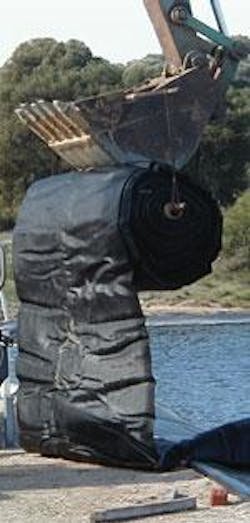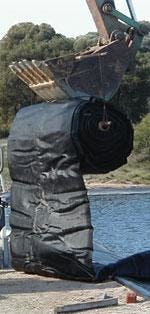Geotextile tube technology adapted for facultative pond
By Jim Ghaswala
Geotextile technology used in eastern Australia to protect the coastal foreshore was successfully adapted to construct a wall across an aerated treatment pond at the Caddadup wastewater treatment plant in Western Australia. The plant serves the rapidly growing suburbs south of Mandurah.
The Water Corporation planned an urgent upgrade to the plant, which was rapidly approaching its design capacity, to increase its capacity from 400 to 1,000 cubic metres of wastewater per day.
The long-term future of the site is yet to be determined following completion of a planning review of the Greater Mandurah region, so the solution required a low cost upgrade that would be consistent with both the short-term and long-term planning for the site. The existing plant consists of a primary pond aerated by two 7.5-kW surface aerators.
The project scope included installation of new monitoring bores, a third aerator and construction of a 50-metre-long dividing wall across the primary pond. The new wall was designed to prevent the short-circuiting of wastewater, resulting in significant process improvements.
In a rectangular or square treatment pond, the inflow and outflow locations are ideally located as far apart as possible to maximise detention times. This is not always possible due to site constraints, and both the inflows and outflow points are sometimes located at adjacent corners. This leads to a "short-circuiting" of the process. In such situations, the designed detention times are not achieved, resulting in an inferior wastewater treatment process. This problem is easily solved by building a wall across most of the pond, thereby forcing the flow-path to be maximised.
The site posed severe space constraints, and it was not possible for a temporary bypass pond to be installed, which would enable the main pond to be emptied for construction. The team solved the problem by using a geo-textile "sausage" to construct the wall. This technology has been used in foreshore protection projects on the eastern seaboard, but it was new to Western Australia.
The project team had to install the new wall while the plant remained in operation. The author, Project Manager Jim Ghaswala, led the project team, which included Water Corporation's Design Manager and wastewater treatment plant operator, and a dredging contractor who installed the geofabric tube.
Water Corporation management held meetings with stakeholders, suppliers and several installers at the site, before implementing the innovative process. Not only was the project team looking at using this technology for the first time, it would use the technology for a radically different purpose.
Eventually the geotextile tube was positioned across the pond surface and a dredge was used to pump sand slurry into the tube. The fabric allowed the tube to expel the water, fill with sand and sink into position. The water used in the process was drawn from the pond and returned with the sand slurry in a closed loop. This process allowed construction to proceed with practically no disruption to treatment plant operations.
The new wall, constructed for less than US$ 14,000 (AUD$ 20,000), saved an estimated US$ 68,000 (AUD$ 100,000), if an equivalent lined temporary pond and electrical supply would have been constructed. This innovative low cost construction technology is now being investigated further to achieve savings in other Water Corporation projects.
The Corporation, after experimenting with a similar process for a couple of years, recently completed desludging wastewater treatment ponds. In this process, a dredge was used to pump out sludge from the bottom of wastewater treatment plant ponds. The sludge was then dewatered in large geofabric bags and later disposed when dry.
Author's NoteJim Ghaswala is a project manager for Water Corporation, located in Perth, Australia. For more information, contact him at Email: [email protected] or visit the website: http://www.watercorporation.com.au


